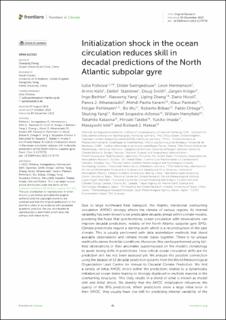| dc.contributor.author | Polkova, Iuliia | |
| dc.contributor.author | Swingedouw, Didier | |
| dc.contributor.author | Hermanson, Leon | |
| dc.contributor.author | Köhl, Armin | |
| dc.contributor.author | Stammer, Detlef | |
| dc.contributor.author | Smith, Doug | |
| dc.contributor.author | Kröger, Jürgen | |
| dc.contributor.author | Bethke, Ingo | |
| dc.contributor.author | Yang, Xiaosong | |
| dc.contributor.author | Zhang, Liping | |
| dc.contributor.author | Nicolì, Dario | |
| dc.contributor.author | Athanasiadis, Panos J. | |
| dc.contributor.author | Karami, Mehdi Pasha | |
| dc.contributor.author | Pankatz, Klaus | |
| dc.contributor.author | Pohlmann, Holger | |
| dc.contributor.author | Wu, Bo | |
| dc.contributor.author | Bilbao, Roberto | |
| dc.contributor.author | Ortega, Pablo | |
| dc.contributor.author | Yang, Shuting | |
| dc.contributor.author | Sospedra-Alfonso, Reinel | |
| dc.contributor.author | Merryfield, William | |
| dc.contributor.author | Kataoka, Takahito | |
| dc.contributor.author | Tatebe, Hiroaki | |
| dc.contributor.author | Imada, Yukiko | |
| dc.contributor.author | Ishii, Masayoshi | |
| dc.contributor.author | Matear, Richard J. | |
| dc.date.accessioned | 2024-03-20T12:11:09Z | |
| dc.date.available | 2024-03-20T12:11:09Z | |
| dc.date.created | 2024-01-08T12:33:08Z | |
| dc.date.issued | 2023 | |
| dc.identifier.issn | 2624-9553 | |
| dc.identifier.uri | https://hdl.handle.net/11250/3123385 | |
| dc.description.abstract | Due to large northward heat transport, the Atlantic meridional overturning circulation (AMOC) strongly affects the climate of various regions. Its internal variability has been shown to be predictable decades ahead within climate models, providing the hope that synchronizing ocean circulation with observations can improve decadal predictions, notably of the North Atlantic subpolar gyre (SPG). Climate predictions require a starting point which is a reconstruction of the past climate. This is usually performed with data assimilation methods that blend available observations and climate model states together. There is no unique method to derive the initial conditions. Moreover, this can be performed using full-field observations or their anomalies superimposed on the model's climatology to avoid strong drifts in predictions. How critical ocean circulation drifts are for prediction skill has not been assessed yet. We analyze this possible connection using the dataset of 12 decadal prediction systems from the World Meteorological Organization Lead Centre for Annual-to-Decadal Climate Prediction. We find a variety of initial AMOC errors within the predictions related to a dynamically imbalanced ocean states leading to strongly displaced or multiple maxima in the overturning structures. This likely results in a blend of what is known as model drift and initial shock. We identify that the AMOC initialization influences the quality of the SPG predictions. When predictions show a large initial error in their AMOC, they usually have low skill for predicting internal variability of the SPG for a time horizon of 6-10 years. Full-field initialized predictions with low AMOC drift show better SPG skill than those with a large AMOC drift. Nevertheless, while the anomaly-initialized predictions do not experience large drifts, they show low SPG skill when skill also present in historical runs is removed using a residual correlation metric. Thus, reducing initial shock and model biases for the ocean circulation in prediction systems might help to improve their prediction for the SPG beyond 5 years. Climate predictions could also benefit from quality-check procedure for assimilation/initialization because currently the research groups only reveal the problems in initialization once the set of predictions has been completed, which is an expensive effort. | en_US |
| dc.language.iso | eng | en_US |
| dc.publisher | Frontiers | en_US |
| dc.rights | Navngivelse 4.0 Internasjonal | * |
| dc.rights.uri | http://creativecommons.org/licenses/by/4.0/deed.no | * |
| dc.title | Initialization shock in the ocean circulation reduces skill in decadal predictions of the North Atlantic subpolar gyre | en_US |
| dc.type | Journal article | en_US |
| dc.type | Peer reviewed | en_US |
| dc.description.version | publishedVersion | en_US |
| dc.rights.holder | Copyright 2023 The Author(s) | en_US |
| dc.source.articlenumber | 1273770 | en_US |
| cristin.ispublished | true | |
| cristin.fulltext | original | |
| cristin.qualitycode | 1 | |
| dc.identifier.doi | 10.3389/fclim.2023.1273770 | |
| dc.identifier.cristin | 2222220 | |
| dc.source.journal | Frontiers in Climate | en_US |
| dc.identifier.citation | Frontiers in Climate. 2023, 5, 1273770. | en_US |
| dc.source.volume | 5 | en_US |

